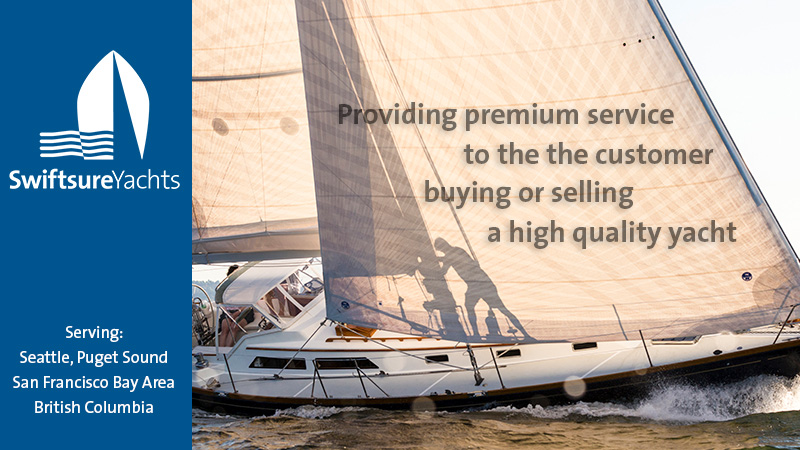
An Olympic Send-Off for Daniela Moroz at StFYC Wednesday Yachting Luncheon
The Paris Olympic Women’s US Kiteboarding representative, Daniela Moroz, is heading to Europe for the final few months of training and competing before the Games’ opening ceremonies on July 26. Daniela is a six-time women’s kite-foiling world champion and four-time US Rolex Yachtswoman of the Year (one Rolex for every US time zone), and is clearly a strong contender for a medal, though, as in all sports, the field is getting increasingly competitive.
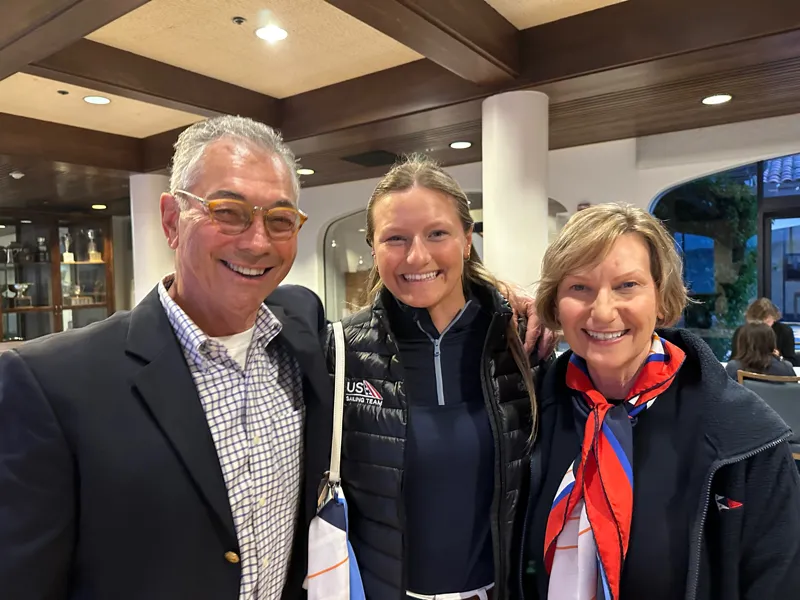
Daniela’s ebullient personality was on display as she addressed the audience at the St. Francis Yacht Club’s Wednesday Yachting Luncheon. The gathering consisted of almost 120 boosters and supporters who, with the help of MC Ron Young, were inspired to contribute to the expensive proposition of mounting an Olympic campaign. The gathered group far exceeded their fund-raising goal to support the coaching, travel, equipment development and all other ingredients necessary when going up against the world’s other well-funded and competitive women’s kiteboarders. You can watch her presentation on YouTube here.
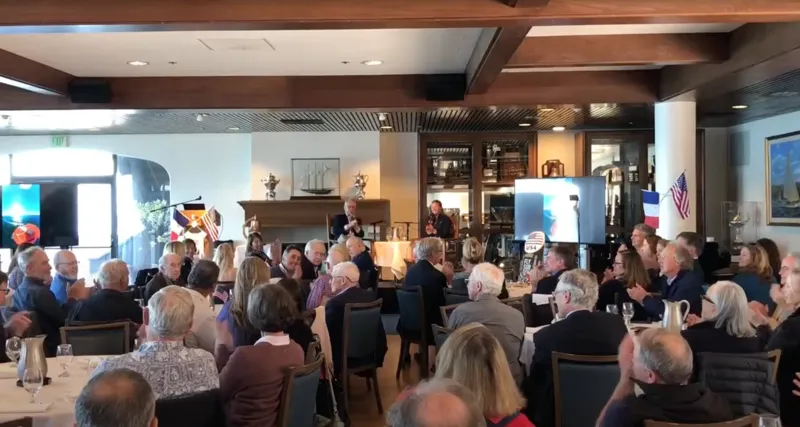
Since winning her first women’s kite-foiling world championship at age 15 in 2016, Daniela has remained an enthusiastic and resilient competitor through the highs and lows of what has been a consistent run at the top of women’s kite foiling. Daniela has continued to develop her skills, and also embraced the challenge of managing the expectations and sports psychology that come with staying at the top of your game over the long haul.
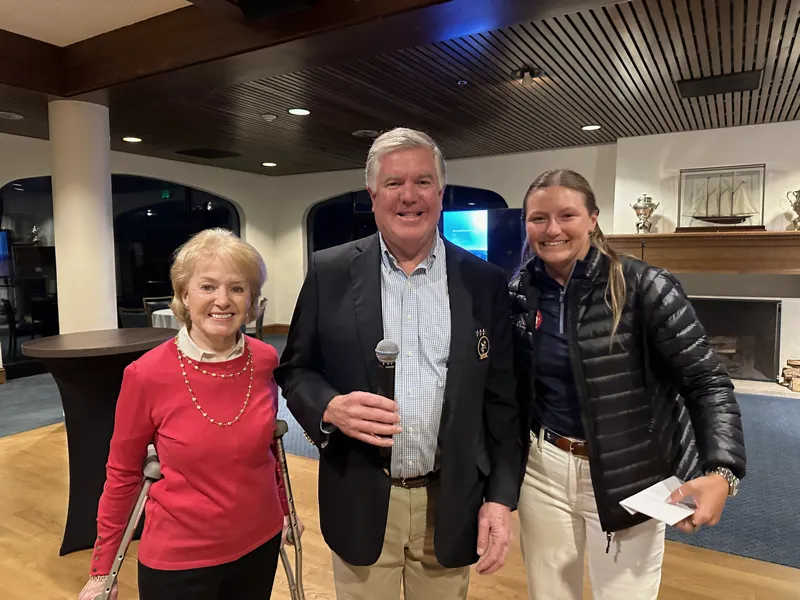
When speaking, Daniela is always quick to credit the San Francisco Bay kiteboarding community and mentors who have always encouraged and challenged her to be her best. It’s a long road to the Olympics for any athlete, and beyond managing your mental, physical and technical abilities for racing is the “business” of running a campaign that includes fundraising, coaching and a team of people to support Olympic success.
When Daniela won her first world championship, kite foiling was not yet an Olympic sport. After a vote in 2018, kite foiling will make its Olympic debut this year in Paris. (The sailing events will be held in Marseille.)
Daniela has a huge fan base of local boosters and admirers who have followed her dedication and hard work over the years. All are wishing her bon voyage and best wishes as she departs for the Olympics and training in Europe in the next couple of weeks.
You can listen to Moe Roddy’s Good Jibes podcast with Daniela here and contribute to her campaign here.
Latitude 38’s March Issue Docking Today at a Distributor Near You!
Welcome to the March issue of Latitude 38. We hope you enjoy this month’s stories, which include everything from Ronnie Simpson’s dismasting during the Global Solo Challenge to No Name’s “manifestly unsafe voyage,” Sue and Mike Proudfoot’s 36-year-long journey with the 38-ft Norwegian ketch Farida, and many more interesting and fun stories.
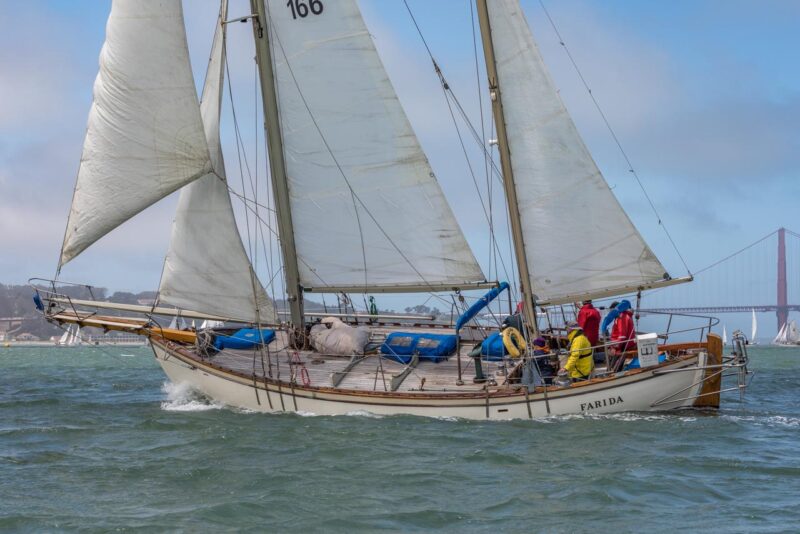
Here’s a preview of what’s inside Latitude 38’s March issue:
Three Bridge Fiasco — Escape From Yerba Buena
As in last year’s Three Bridge Fiasco, this year’s rounding of Yerba Buena/Treasure Island proved to be the biggest sticking point for hundreds of sailors. Out of a final count of 299 boats registered, 274 started and 160 were able to finish on Saturday, January 27.
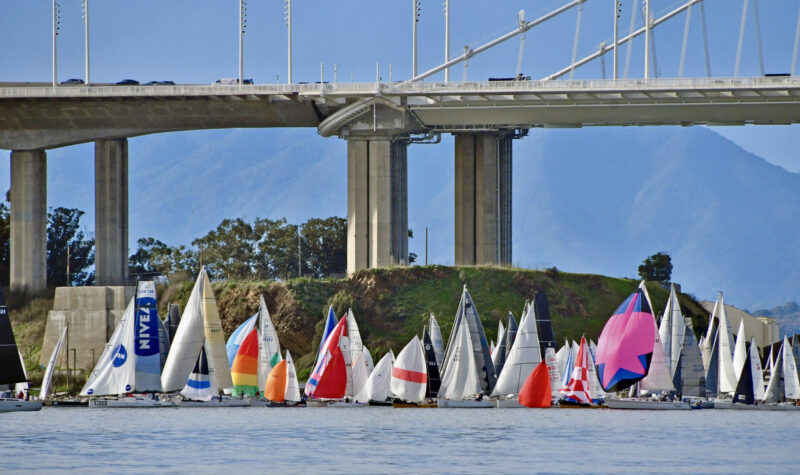
No Name’s First Leg — Manifestly Unsafe Voyage
In April 2023, we published a story of Stephen Wolf, who left San Francisco Bay in the early ’70s on a folding plywood 24-ft Piver Nugget trimaran for an extended cruise of unknown destination and time. One thing led to another, and unintentionally, it turned into an eight-year circumnavigation. Stephen had already sailed the boat from San Francisco to Mexico with friends and singlehanded it to Hawaii, but taking this well-built but light, open tri without an engine or electronics around the world today would certainly be classified as a “manifestly unsafe voyage.”
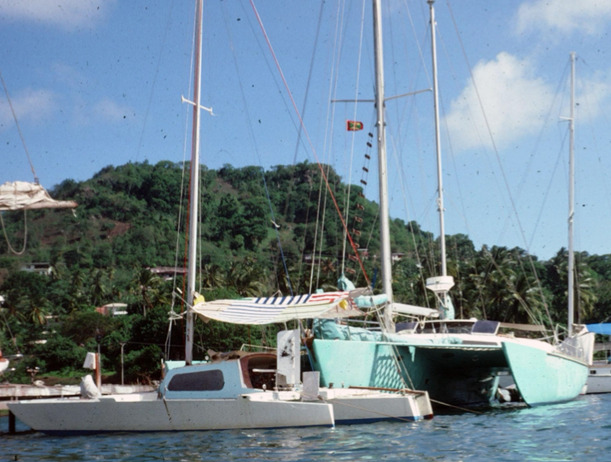
Ronnie Simpson Dismasts In Atlantic
“More than three quarters of the way around the world in the Global Solo Challenge and past all three of the Great Capes, I could see the light at the end of the tunnel. Then, the 75-foot-tall carbon fiber mast on my vintage Open 50 came crashing down. Since rounding Cape Horn on February 2 in close to 60 knots of breeze, my weather while climbing the Atlantic had been incredibly unfortunate. My weather router Jason and I watched with concern as the South American continent baked in the intense summer sunlight, then spun out a depression that would meet me head-on. Sailing upwind and then close reaching, I was getting lifted to a proper course when my race came to an abrupt end at about 11:30 p.m. on February 11. With 30-40 knots of breeze and three reefs and a storm jib, conditions were beginning to moderate, though the sea state was still deteriorating.”
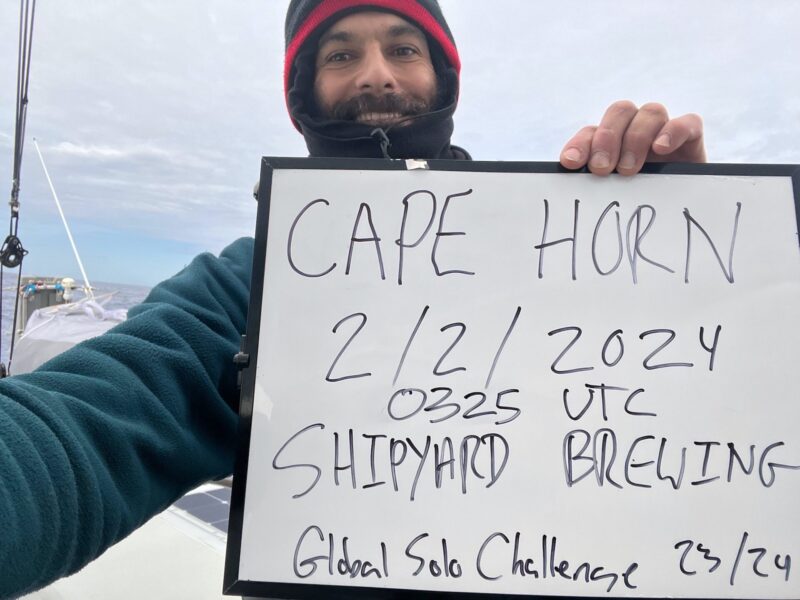
Plus, take a peek at our regular monthly columns:
- Letters: Capsize at Golden Gate Midwinters; A Perfect Fiasco, But We Need To Get Better; We Ask Again: Why Not Have AIS for YRA Races in the Bay? Surveying, and Shooting, the Berkeley Pier; and many more Letters to the Editor.
- Sightings: After Years at Anchor, Iconic Vadura Destroyed; Good Fun and Good Humans at PYSF; The Proudfoots’ Project, Part 1; and more great stories.
- Max Ebb: A Pox on Both Their Houses..
- Racing Sheet: Some California Laser sailors took a break from winter to head Down Under for the ILCA Masters Worlds. Meanwhile, the Northern Hemisphere winter season rolled on; this month we visit Island, Monterey Peninsula, South Beach, Berkeley, San Diego, Golden Gate, Corinthian and Coral Reef YCs and RegattaPRO. We also publish a race committee request, and Box Scores returns.
- Changes in Latitudes: This month we cover Salty Dancer’s scary grounding at Puerto Escondido; Bear North’s long journey from build to cruising Mexico; Noctiluca’s built-for-comfort-not-for-speed journey south; and a duffel bag full of Cruise Notes.
- Loose Lips: We share February’s Caption Contest(!) winners.
- The sailboat owners and buyers’ bible, Classy Classifieds.
If you’re a subscriber, your magazine is on its way. If you like to collect your own and have a chat with the folks in the store or marina office, here’s a map of where you can find Latitude 38 magazine.
NOTE: Just as we posted our new March issue this morning, one of our alert readers noted our PDF download link wasn’t working. Mauri Miner wrote us immediately saying, “The ‘download’ link is missing on the latest issue, March 2024. Please fix, for those of us who prefer to download and read offline.”
Thank you. Mauri, from Seattle. We’re always appreciative of readers, no matter how they read the magazine, and also for offering feedback to help us keep things running smoothly.
And for those who like to read the paper version, offline, stop in and visit Lane at Modern Sailing in Berkeley.
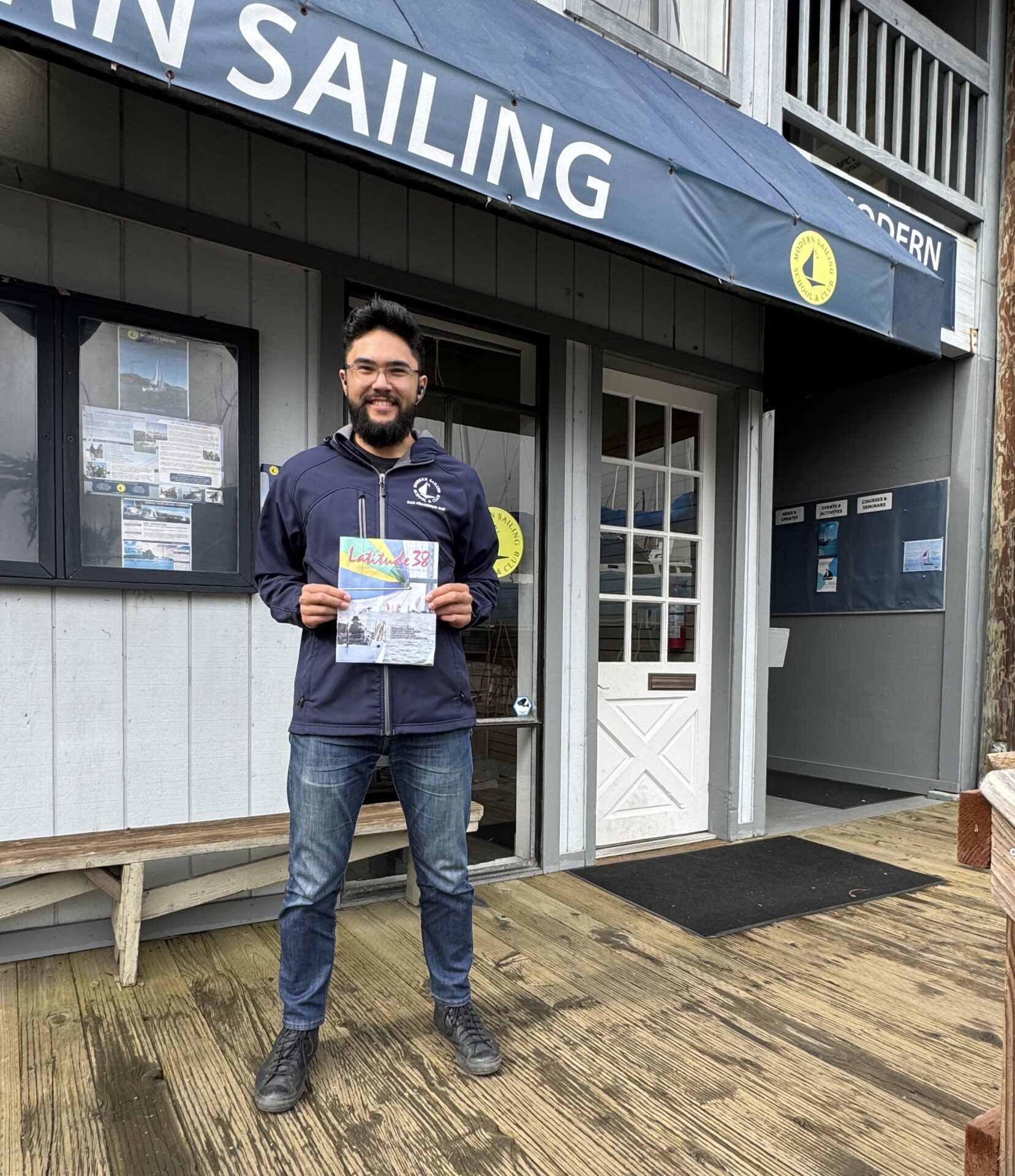
Quality Yachts With Premium Service From Swiftsure Yachts
Swiftsure Yachts offers exceptional service, quality brokerage boats and new yachts for world cruising. Visit our website swiftsureyachts.com.
Proposed Senate Bill Addresses Marine Flare Disposal Issue in California
Marine flare disposal is a subject that raises its fiery head on an annual, perhaps even biannual, basis. Looking back over our archives, we can see that we publish at least one story each year about marine flare collection events in various locations around the Bay Area. Events that are infrequent and often inconveniently timed or located.
Recently we were alerted to a new senate bill introduced to the California Legislature by Senator Catherine Blakespear, representing Senate District 38 in western San Diego and Orange counties — SB 1066: The Marine Flare Producer Responsibility Act. The intention is to create a program whereby marine flares are collected and disposed of in a safe and proper manner, free and convenient to the consumer.
Having read the PDF of the bill introduced by Senator Blakespear on February 12, our takeaways are as follows:
The producer responsibility program would be overseen by the Department of Toxic Substances Control (DTSC). The bill would require any producer, importer, wholesaler or retailer (depending on who is where in the chain) of a covered product in the state of California to register with a Producer Responsibility Organization (PRO), which would manage the collection and disposal of the covered product. In this bill, “covered product” is defined as “a pyrotechnic device that produces a brilliant light or a plume of colorful smoke as a visual distress signal on marine vessels to attract attention and pinpoint a boater’s location in an emergency.” In ordinary terms, a marine flare.
The PRO would be required to “develop and implement a producer responsibility plan for the collection, transportation, and the safe and proper management of covered products.” The plan would need to include accounting for funding of the program and several contingencies. That plan then needs to be registered with and approved by the DTSC.
The information we read suggests the PRO would be “an organization that is exempt from taxation under Section 501(c)(3) of the federal Internal Revenue Code of 1986…” — so, a charitable organization of some sort.
Next, the collections would be convenient and free to the consumer: “… shall include permanent collections sites and may include temporary collections sites.”
It’s starting to sound pretty good, right?
The Marine Flare Producer Responsibility Act, sponsored by the National Stewardship Action Council (NSAC), is said to be “a first of its kind in the US.”
The NSAC writes on its website: “’Boaters love the water and want to protect it from pollution,’ Sen. Blakespear said. ‘Properly disposing of unwanted marine flares, which can contain toxic perchlorate and expire approximately every three years, should be as convenient as it is to purchase them. SB 1066 establishes a way to do that.’”
The website then quotes Courtney Scott, Household Hazardous Waste Program Manager for Zero Waste Sonoma. “Historically, the costs to manage unwanted marine flares have been socialized by every ratepayer, whether they own and operate a boat or not.
“In 2023, it cost an estimated $185 to properly dispose of one unwanted marine flare, which can be purchased new for approximately $13.”
As we understand, the PRO will need to source that $185 from the producer, importer or distributor of the $13 product — who, again, needs to be properly registered with the PRO. The PRO can also apply for funding through other sources, but any money the PRO collects will need to pay for not only the flare disposals, but also the collections, and all the costs incurred by its association with, and obeisance to, the DTSC guidelines, and all the DTSC’s costs in overseeing the program.
Are you thinking what we’re thinking? How long before the cost of flares skyrockets? That said, we do applaud those who put their heads together to look for a solution to the decades-long problem of marine flare disposal.
Just to be clear, nothing is going to happen overnight. The bill has yet to be passed, and then there will be the obligatory several years of lead time before the bill comes into force, and then the times allowed for the creation of the necessary organizational infrastructure.
If anyone is interested in reading the bill in its current form, you can find it here.
Thanks very much to our friend Bob Adams for bringing this to our attention.
Following the Trail of San Francisco’s Buried Ships
In 2023, historian and author Ron S. Filion published his book Buried Ships of San Francisco, which includes a veritable treasure map of San Francisco, marking the locations of approximately 70 sailing ships (or their remains) that he believes are buried beneath San Francisco’s busy streets. The ships are among those that arrived at the city docks carrying a good number of the estimated 80,000 people who came to California in 1848-1849 — earning themselves the name “49-ers” — after hearing of the gold discovery.
Filion writes, “… well over a thousand ships descended on the small village of Yerba Buena (now San Francisco) and anchored in the shallow cove on the eastern edge of town.”
Many of the ships were abandoned as their passengers and crew made for the hills to seek their own fortunes in gold. Filion describes the scene as a “burgeoning town littered with scores of discarded hulks.” Some of the ships were repurposed for storage and housing, while others were destroyed or burned, or sank. As the waterfront expanded and wharves were built, the cove was filled in, burying many in the foundations of what is now San Francisco’s Financial District.
One particular ship, the Niantic, was beached in 1849 at what is now the corner of Clay and Sansome streets. The Niantic brought 248 passengers from Panama to San Francisco. Afterwards she was used as a storeship until burning to the mud flats in the San Francisco Fire of May 1851. She is listed as the farthest inland of the 44 ships known to be buried in downtown San Francisco.
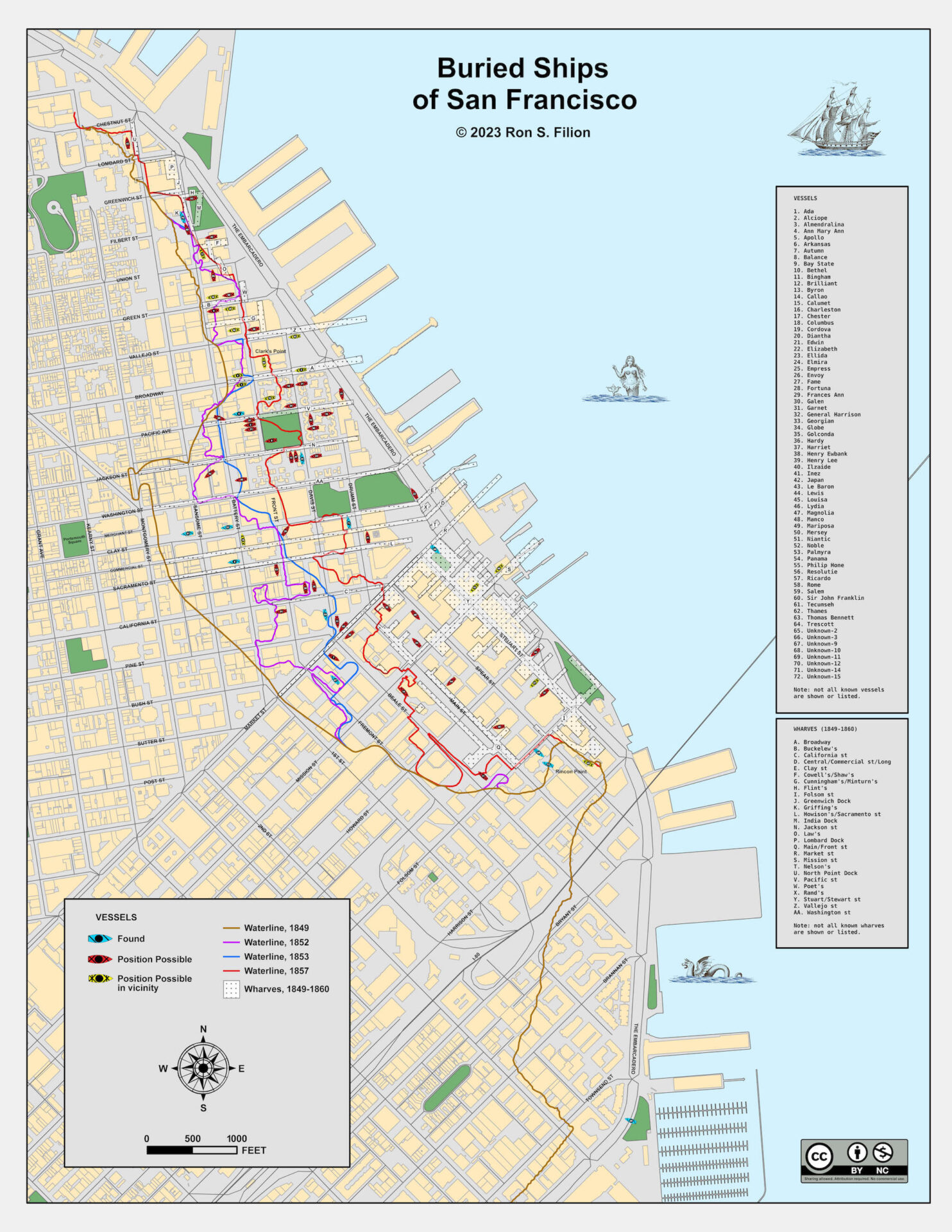
Other ships include the Rome, which lies buried across the road from the Ferry Building; the Apollo, which is believed to lie beneath the Federal Reserve Building; and an unnamed ship that became part of the Old Ship Saloon on Pacific Avenue. Down the street you could find the Arkansas.
The idea of San Francisco’s being built upon the bones of old ships is intriguing. We already consider the city to be a waterfront or sailing-oriented city, but to think of it in physical terms adds much to the character we envisage.
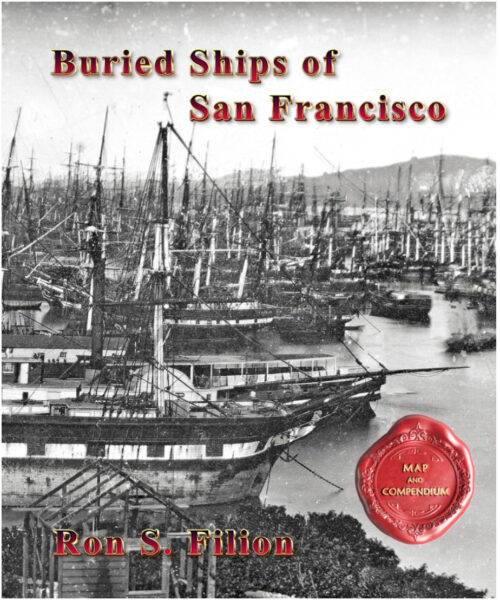
If you read Filion’s book or follow his map, let us know what you discover.
Get Onboard With the ‘Latitude 38 BOGO Special’
This offer is available to new or returning subscribers only. This means first time subscribers, or you are a previous subscriber whose subscription lapsed one or more years ago. The same applies to your friend.
The ‘Latitude 38 BOGO Special’ will run from today through April 20.
The six-month subscription rates are as follows:
$18 – Third-Class Postage (US only, delivery time 2-3 weeks — USPS will not forward Third-Class mail)
$27.50 – First-Class Postage (US only, delivery time 2-3 days — FPO/APO [military] and correctional-facility subscriptions MUST be First Class.)
Follow the link below to sign up and give yourself and a friend the best gift ever!
Fill in the form for yourself, then write to [email protected] to provide the details of the second subscription (name, mailing address, phone number).
*This offer includes a free subscription to our 3 x weekly online stories in ‘Lectronic Latitude.

